FRIDAY'S SCRIPT TIP:
ACTION IS CHARACTER
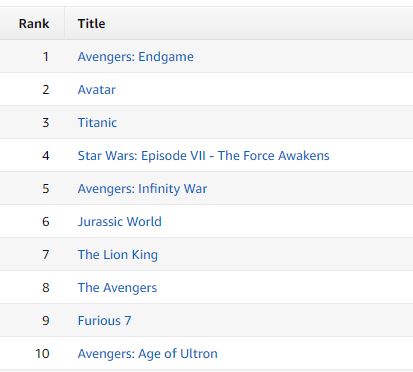
FAST X (10) was released on May 19, 2023. We didn't have a FAST film this year.... but the year after next?
You may not have noticed that the FAST & FURIOUS movie, FURIOUS SEVEN, which was #9 on the All Time Worldwide Box Office charts. SEVEN is in in the TOP TEN ALL TIME WORLDWIDE BOX OFFICE. Yes, All Time (which includes your ten favorite movies). Yes, Worldwide (which includes every film released in every country in the world... this film was popular all over the globe!). Yes, that's not adjusted for inflation... so GONE WITH THE WIND is probably still #1 and FURIOUS SEVEN is much farther down the adjusted for inflation list.
But FURIOUS SEVEN (with it's new director to the franchise and unexpected stop in the middle of production when one of the stars was killed in a car accident) (so that the screenplay had to be rewritten and completely restructured) made a ton of money... and has managed to make more money than all but six other films in the world since the dawn of cinema.
WTF????
You may think these films are stupid, but actually they are very smart. From the very first film they have focused on *character* as well as the fast cars and hot women (and men). Audiences like the characters and keep coming back for more. The first film was never meant to be anything other than a basic popcorn film... not a "homerun" movie, more of a "double". Not a tentpole, just a typical genre film. But it made much more money than expected and those people who buy the tickets and secretly pay our salaries in the film biz loved it. So they made a sequel without Vin Diesel... which did okay, but not as much as they expected. At that point, it was decided to continue the series as Direct To Video features. Universal had done great business with the AMERICAN PIE film DTV sequels and thought this was a good fit.

But the story for the third film was pretty good, even though it didn't have any cast members from the first two films. It was a father and son story where a teenager in Japan comes of age in the world of street racing (focusing on drifting) with some Yakuza criminals thrown in to add excitement. Though I don't know the backstory, my *guess* is that the film was made during Universal's ownership by a Japanese company and they were looking to make a film that would do well in Japan. My further *guess* is that it got a theatrical release in the USA in order to be more attractive to the Japanese theatrical audience. The film didn't break *any* box office records and the series would probably have gone to the Home Entertainment division except...
Vin Diesel wanted to come back... and so did Paul Walker... and so did the rest of the cast. So FAST & FURIOUS 4 would have "all the original parts", plus a screenplay by TOKYO DRIFT's Chris Morgan. Now, whether this was Morgan's idea or the producer's I do not know, but I'm going to credit Morgan because it's a story decision: instead of looking at FAST & FURIOUS 4 as a single movie, they decided to look at it as a chapter in a much larger story, and the first 3 films were also chapters. So each *chapter* might have its own individual plot, but it would also have part of the larger story... the way a TV series might have a crime that will be solved this week, but also a larger story about the protagonist's life. This turned the focus on the *characters* and kind of turned the FAST & FURIOUS franchise into a bit of a soap opera.
(Spoilers)

The event that brings all of the characters together for FAST & FURIOUS 4 is the murder of Letty (Michelle Rodriguez) who was Dom's (Vin Diesel) girlfriend. This was probably done because I think she was on LOST at the time and couldn't be in the whole film. But it was a genius decision because it made the focus of that film about the loss of a "family member" (which is emotional). The other genius decision was to have Han (Sung Kang) from TOKYO DRIFT be part of the family... and make TOKYO DRIFT's story kind of a "flash forward" to *after* FAST & FURIOUS 6. They filmed that chapter out of order! Since Letty was dead, Dom gets a new potential love interest in FAST & FURIOUS 4, Gisele (Gia Gadot) who is on the villain's team, and then switches... but Dom is still hung up on Letty, so no romance blossoms... but Gisele does become part of the "family".
That lack of romance may have been because Morgan knew that eventually Letty would come back (FAST & FURIOUS 6) and have amnesia (told you: soap opera) and would have to learn to fall in love with Dom all over again.
But the key to the success of this series is that we want to see the new movie to find out what happens in the character's *personal lives*. The ticket buyers love the characters! Each "chapter" is designed to give us that strong B story about the character's relationships with each other... the soap opera stuff. FURIOUS 7 opens up with Dom taking Letty to a street racing group in the Dominican Republic that they created... hoping that will jog her memory of their past relationship. We first see Brian driving his kid to school in a minivan, and wishing he were street racing. Is he bored with marriage and family life? Every character has an emotional journey in FURIOUS 7 that is all part of the larger story... but we only see part of it in this chapter. The character "B story" is the franchise's "A story"... and that's why people keep paying to see these films. Everyone says number five was the best, and I think that's when they first noticed that these were chapters in a larger story.
EMOTIONAL ACTION

Our job as writers is to give the audience
an emotional experience, whether it's fear from a horror movie,
sadness from a tragedy, romance from a love story, joy and
laughter from a comedy, excitement from an action movie. Our job
is to create those emotions in the audience through our
scripts.
Without emotions what we end up with is one of those boring
science movies from high school where the dispassionate narrator
drones on and on and on. Those things put me to sleep. You want
your action script to have juice, excitement, sparks. Big drama,
big emotions... move that audience gear as much as you can.
Action films are all about life or death situations, and those
are about the most emotionally charged situations I can think of.
When you are writing an action scene, remember to make it
emotional as well as physical... we're exploring character
through actions.
We not only want to create a balance between action and
character, we want to use action to *explore* character. We want
the action scenes to be ABOUT character - to demonstrate
character through actions and reactions to events. In the revised version of
THE SECRETS OF ACTION SCREENWRITING I have two
chapters about showing character through action scenes. If your action scene tells us
that your tough cop is tough, um, we already knew that. We want to dig below the surface of characters
and use the action scenes to explore the character's emotional (inner) conflict. Okay, he's a tough cop
- but why? And what is that thing tearing him apart inside? What is that flaw that he is wrestling with?
If the purpose of your action scene is to give the
audience character information, make sure it's something we do not know... and something that is more than
just surface. Find ways to *test*
your character through the actions - force them to make tough decisions that define them. Force them to deal with
their personal problems... while firing a gun with a never-ending magazine.
THEMATIC ACTION

In FACE/OFF the central conflict is FBI Agent Sean Archer's (John Travolta)
pursuit of the man who killed his son... at the expense of the
rest of his family. Archer believes that the way to be a good husband and father is
to track down his son's killer and waste the sucker... even if
it means completely ignoring his wife and daughter. This is his character flaw, and the film
creates action situations that force him to deal with that flaw. Most of the action scenes
have a family-based emotional component in them, whether it's Archer rescuing his
daughter from the villain Castor Troy (Nic Cage)at the end, or Archer rescuing the Villain's son
in the middle of a massive shoot out, or the henchman taking a
bullet so that his sister (Gina Gershon) can live. There are
family ties to almost every action sequence - they are *thematic* scenes.
Theme can be a point, an issue, or just some aspect of the human condition that your script
is exploring; but you should be able to find it in every scene... including the ones with giant fireballs.
One of the signs of a bad action screenplay are action scenes that are interchangeable - they could
be from any movie. You want your action scenes to be *specific* to this character and this story. (Are you
listening Michael Bay?)
The *choices* that Archer makes in each action scene shows his character's growth. He is battling
his own emotional problems as he battles Castor Troy or the prisoners or his own agency. These scenes
are designed to make Archer make a choice between family and his revenge. All of the
action scenes are *designed* by the screenwriters to show character by setting up
situations involving families... and firearms!
Remember that action is character. Action scenes *expose*
character. That is one of the primary purposes of any scene - to
expose character. Scenes should also advance the plot, illustrate
the theme (if possible) and entertain the audience. Yes, that's a
lot of work. But if your action scene isn't telling us anything
about the character, isn't emotionally involving, it's just a
high school science movie. Our job is to provide emotions, to
keep that audience gear moving.
Once you have your hero's emotional problem (character arc or flaw),
come up with a list of action scenes that will force him or her
to deal with that problem. Scenes that force them to solve that
emotional problem in order to survive. If two people are running
away from an escaped tiger, and one trips and falls... does the
other go back to rescue them (and put his own life in peril for a
stranger)? By creating a situation where *physical actions* show
decisions we can explore character through actions.
EMOTIONS INTO ACTIONS

But what about movies like THE FAST AND THE FURIOUS (original)? Glad you
asked! Though TF&TF may have tied with POOTIE TANG for Oscar
nominations the year it was released, it still uses its action scenes to *tell
the story* and to *explore character* through decisions we can see.
Our protagonist Brian O'Conner (played by the late Paul Walker) is a rookie cop searching for a family.
He's joined a brotherhood of policeman, but that's not providing what he's looking for - it's all stern
fathers... But when he goes undercover and joins "The Team", the hoods treat him like a brother.
Leader Dom Toretto (Vin Diesel) welcomes him into his home and later confides to him about the death
of his father. The crooks have family barbecues. They take care of each other. When Brian asks
Mia Toretto (Jordanna Brewster) about the team, and she tells him that Dom went to school with a
couple of them and just adopted the others.
But like all big families, there's a little sibling rivalry - Brian doesn't get along with one of
the guys on the team named Vince (played by Matt Schulze). They are like rival brothers looking for
Dom's love... and Brian has taken Vince's place as Dom's right hand man. So Brian and Vince get into a
fist fight the moment they meet. This is the one guy in the family he doesn't love.
Emotional Decisions are the key to great actions scenes. And there needs to be consequences for
these decisions. And the we must continue to create difficult decisions with serious emotional
consequences.
Cut to the big action scene at the end of F&F, where Brian discovers his family is going to pull
a heist that's really a trap set by his old family, the police. Our hero is now torn between his duty
as a policeman and his family (the crooks). Which side is he on? What will he decide to do? It's a
dilemma where either decision has serious consequences. Does he betray his police family or does he
betray his criminal family? He decides to go warn the criminal family and prevent the heist before
it even begins...
By the time he gets there, it's too late. The robbery of a big rig truck is in progress - two of
the family's cars have crashed and a family member is trapped on the side of the truck as the driver
fires a shotgun at them. This family member will DIE unless our hero saves them. Will our hero further
cross the line into criminal activity by saving this person? Another big decision with emotional
consequences.
To make it a better decision, instead of it being Mia, the woman he loves, or his new best friend Dom,
it's Vince: the one family member he hates. The one guy who he always fights with. Will he risk his life
to save the least liked member of his criminal family? See how difficult this decision is? And it's in
the middle of a *moving* heist scene filled with racing cars and a shoot out! It's an emotional decision,
a character scene, in the *middle* of the action scene.
What do you think he decides?
The entire action scene is filled with decisions that
pit our hero's job against our hero's survival against our hero's
need for family against past problems with this family member.
The scene *shows* the emotional struggle through the physical
struggle. It's a situation designed to *show* our hero's emotional
problem through actions and shotguns and big trucks and fast cars
and cool stunts. Start with the character, start with the emotions...
then find the action scene that illustrates these things.
MAKE IT VISUAL!

Right after that truck hijack scene there's another good example of visual
storytelling. Our hero radios for a medical helicopter - burning
his job as a cop *and* his friendship with Diesel at the same time.
Diesel storms off to his car. When the helicopter comes, our hero
carries the wounded guy to it... leaving Jordanna Brewster
between Diesel and our hero. Both call out to her: Love or
family? She must decide which to go with. This turns an *emotional decision*
into a *physical action* - she has to run to Vin Diesel
and the car or our hero and the helicopter. She picks family, and
runs to the car.
Remember to make your action scenes emotional. To use them as
a way to show decisions. The conflict in an action scene is the
conflict in the screenplay is the emotional conflict that your
protagonist is struggling with. They're all connected.
An action scene is a *character scene* - what does this scene tell us about the character that we did not know? Or what *decision* does this action scene force the character to make? We want to use those car chases and shoot outs and explosions to *explore character*.
An action scene is also a *story scene* - if you can remove an action scene and the story still works - get it out of there! What you have is very exciting filler. If this action scene can be used in some other screenplay - get it out of there! What you have is a *generic* action scene that has nothing to do with your story and screenplay. If the action scene just gets character from A to B, but doesn't *change the direction of the story* - it is filler material.
FAST FIVE also uses action to explore character... more on that in a later tip!
FAST SIX... no so much. But it has a great protagonist/antagonist face off about how each has a moral code which is at odds with the other.
FURIOUS SEVEN... uses action to *show* character! There's a great scene after the rescue of Ramsey where she identifies each individual character based on *how they drove* in the rescue scene. Ex cop or ex military (Brian), Tech nerd (Tej), Mr. Alpha (Don), Mrs. Alpha (Letty), and Joker (Roman).
FATE OF THE FURIOUS... uses action to show character when Dom seems to go against his "family" - so action scene after action scene has him betraying his friends... in car chases involving submarines.
FAST & FURIOUS 11 will speed into cinemas in 2026!
BRAND NEW!
How Do I do That?

101 SCREENWRITING ANSWERS Blue Book!
New to screenwriting? You probably have questions! How do I get an Agent? How do I write a phone conversation? Do I need a Mentor? What’s does VO and OC and OS mean? What is proper screenplay format? Should I use a pen name? Do I need to movie to Hollywood? What’s the difference between a Producer and a Production Manager, and which should I sell my script to? How do I write a Text Message? Should I Copyright or WGA register my script? Can I Direct or Star? How do I write an Improvised scene? Overcoming Writer’s Block? How do I write a Sex Scene? And many many more! This book has the answers to the 101 Most Asked Questions from new screenwriters! Everything you need to know to begin writing your screenplay!
All of the answers you need to know, from a working professional screenwriter with 20 produced films and a new movie made for a major streaming service in 2023!
Only $4.99
NEW!!!
Can You Make It bigger?

BLOCKBUSTERS (and BEACH READS) Blue Book!
Writing something EPIC?
Over 500 Pages, ONLY : $4.99!
Thinking about writing a big Disaster Movie? An Historical Epic? An Epic Adventure Film? Or maybe you like Gladiator Movies? This book looks at writing Blockbusters and those Big Fat Beach Read novels - anything epic! Usng movies like JAWS, POSEIDON ADVENTURE, LAWRENCE OF ARABIA, THE GUNS OF NAVARONE, and those MARVEL and FAST & FURIOUS flicks as examples. What *is* a Blockbuster? 107 years of Blockbuster history! Blockbuster Characters. Blockbuster Story Types! Why modern Blockbusters are soap operas! Social Issues in Blcokbusters? Big Emotions! Keeping All Of Those Characters Distinctive! How to avoid the Big problems found in Big Movies and books! More! If you are writing a Big Event Movie or a Big Fat Novel, there are tips and techniques to help you!
Only $4.99
NEW!!
All About Endings!
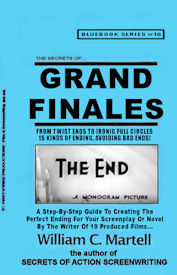
GRAND FINALES Blue Book!
The Perfect Ending For Your Story!
The First Ten Pages Of Your Screenplay Are Critical,
But What About The Last 10 Pages?
Creating the perfect ending to your story! This 100,000 word book shows you how to end your story with a bang, rather than a whimper. Everything from Resolution Order to Act Three Tools to Happy or Sad Endings? to How The Beginning Of Your Story Has Clues To The Ending (in case you were having trouble figuring out how the story should end) to Falling Action to How To Avoid Bad Endings to Writing The Perfect Twist Ending to Setting Up Sequels & Series to Emotional Resolutions to How To Write Post Credit Sequences to Avoiding Deus Ex Machinas, to 20 Different Types Of Ends (and how to write them) and much more! Everything about endings for your screenplay or novel!
Only$4.99
BRAND NEW
All About LOGLINES, TREATMENTS, and PITCHING!

LOGLINES, TREATMENTS, and PITCHING! Blue Book!
Distilling Your Screenplay!
Loglines, Treatments, Pitching, Look Books, Pitch Decks, One Pagers, Rip-O-Matics?
You have written a brilliant 110 page screenplay, but how do you get anyone to read it? You need to distill it down into some form of verbal moonshine or story rocket fuel that will ignite that bored development executive or manager or agent and get them to request your screenplay. But how do you shrink those 110 pages into a 25 word logline or a 2 minute elevator pitch or a one page synopsis or a short paragraph? This 100,000 word book shows you how! Everything you need to know! From common logline mistakes (and how to solve them) to how your pitch can reveal story problems to the 4 types of pitches!
272 pages - ONLY $4.99!
NEW: WRITE IT: FILM IT!

Making Your Own Movie?
Writing An Indie Film?
Writing A Low Budget Genre Script To Sell?
Writing A Made For TV Holiday Movie?
You will be writing for BUDGET. On a standard spec screenplay, you don’t have to think about budget, but these types of screenplays writing with budget in mind is critical!
If you are making your own movie, budget, is even more important - and you need to think about budget *before* you write your screenplay... or you will end up with a script that you can’t afford to make (or is a struggle to make). Everyone is making their own films these days, and even if you have done it before there are lots of great techniques in this book to get more money on screen - for less money! You can make a film that looks like it cost millions for pocket change.
344 pages - SALE:: $7.99!
NEW!

THE MISSION IMPOSSIBLE MOVIES
NEW: Updates On Films 7 & 8 Casting!
All Six Movies analyzed! All of the mission tapes, all of the “that’s impossible!” set pieces and stunts, the cons and capers - and how these scenes work, the twists and double crosses, the tension and suspense (and how to generate it), the concept of each film as a stand alone with a different director calling the shots (broken in the sixth film), the gadgets, the masks, the stories, the co-stars and team members (one team member has been in every film), the stunts Tom Cruise actually did (and the ones he didn’t), and so much more! Over 120,000 words of fun info!
THE MISSION IMPOSSIBLE MOVIES - 347 pages - Only $3.99 !
NO KINDLE REQUIRED! Get the *free* app (any device, except your Mr. Coffee) on the order page on Amazon!

BRAND NEW!
*** THE BOURNE MOVIES
All five "Bourne" movies (including "Legacy" and it's potential sequels) - what are the techniques used to keep the characters and scenes exciting and involving? Reinventing the thriller genre...
or following the "formula"? Five films - each with an interesting experiment! A detailed analysis of each
of the films, the way these thrillers work... as well as a complete list of box office and critical
statistics for each film. This book is great for writers, directors, and just fans of the series.
268 pages - Only $3.99
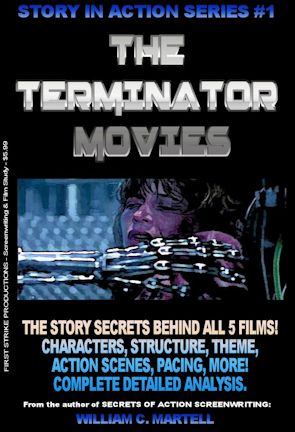
Over 240 pages!
*** THE TERMINATOR MOVIES *** - For Kindle!
He's back! The release of "Terminator: Dark Fate" is set to begin a new trilogy in
the Terminator story... 35 years after the first film was released. What draws us to these films about
a cybernetic organism from the future sent back in time? Why is there a new proposed trilogy every few
years? This book looks at all five Terminator movies from a story standpoint - what makes them work
(or not)? What are the techniques used to keep the characters and scenes exciting and involving? How
about those secret story details you may not have noticed? Containing a detailed analysis of each of
the five films so far, this book delves into the way these stories work... as well as a complete list of
box office and critical statistics for each film. This book is great for writers, directors, and just
fans of the series.
ONLY $3.99 - and no postage!
Tips FAQ

My New Script Secrets Newsletter!

NEW BOOKS!
BRAND NEW
OUTLINES & THE THEMATIC!
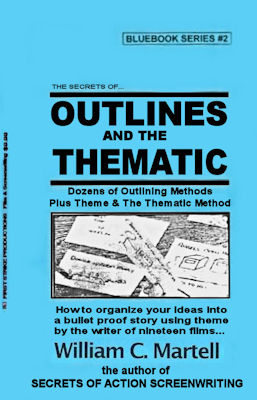
OUTLINES & THE THEMATIC Blue Book.
ARE YOUR SCENES IN THE RIGHT ORDER?
AND ARE THEY THE RIGHT SCENES?
Your story is like a road trip... but where are you going? What's the best route to get there? What are the best sights to see along the way? Just as you plan a vacation instead of just jump in the car and start driving, it's a good idea to plan your story. An artist does sketches before breaking out the oils, so why shouldn't a writer do the same? This Blue Book looks at various outlining methods used by professional screenwriters like Wesley Strick, Paul Schrader, John August, and others... as well as a guest chapter on novel outlines. Plus a whole section on the Thematic Method of generating scenes and characters and other elements that will be part of your outline. The three stages of writing are: Pre-writing, Writing, and Rewriting... this book looks at that first stage and how to use it to improve your screenplays and novels.
Only $4.99!
ALSO NEW!
DESCRIPTION & VOICE Blue Book!
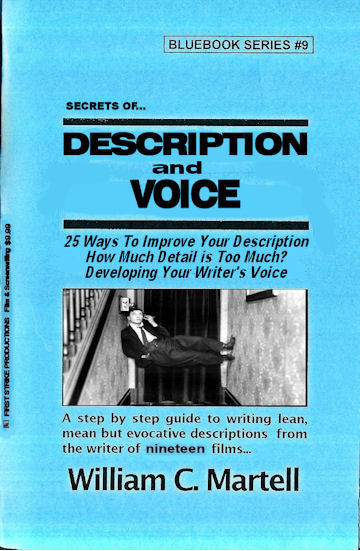
DESCRIPTION & VOICE Blue Book.
IS HALF OF YOUR STORY IN TROUBLE?
Most screenplays are about a 50/50 split between dialogue and description - which means your description is just as important as your dialogue. It just gets less press because the audience never sees it, the same reason why screenwriters get less press than movie stars. But your story will never get to the audience until readers and development executives read your script... so it is a very important factor. Until the movie is made the screenplay is the movie and must be just as exciting as the movie. So how do you make your screenplay exciting to read? Description is important in a novel as well, and the “audience” does read it... how do we write riveting description?
Only $4.99!
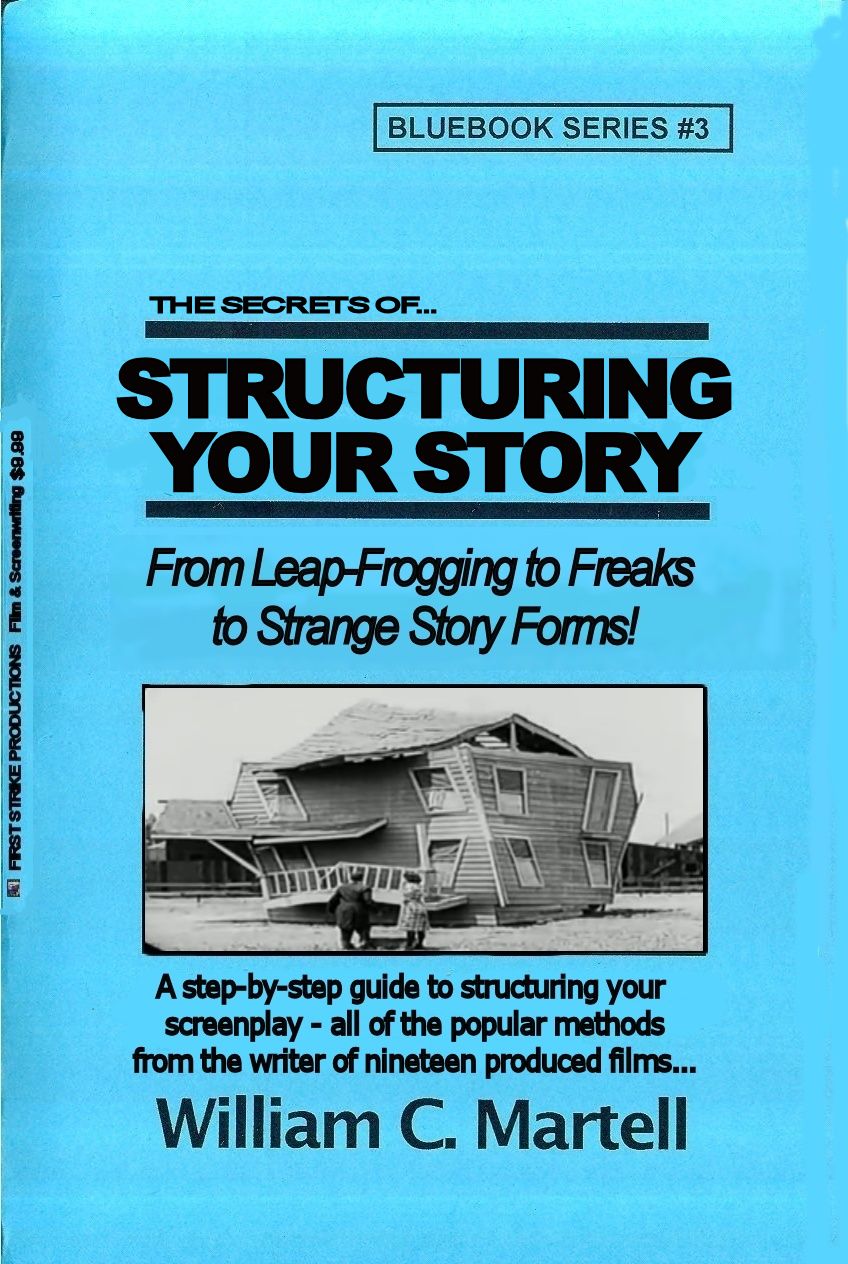
NEW AND HOT!
*** STRUCTURING YOUR STORY *** - For Kindle!
William Goldman says the most important single element of any screenplay is structure. It’s the skeleton under the flesh and blood of your story. Without it, you have a spineless, formless, mess... a slug! How do you make sure your structure is strong enough to support your story? How do you prevent your story from becoming a slug? This Blue Book explores different types of popular structures from the basic three act structure to more obscure methods like leap-frogging. We also look at structure as a verb as well as a noun, and techniques for structuring your story for maximum emotional impact. Most of the other books just look at *structure* and ignore the art of *structuring* your story. Techniques to make your story a page turner... instead of a slug!
Only $4.99 - and no postage!
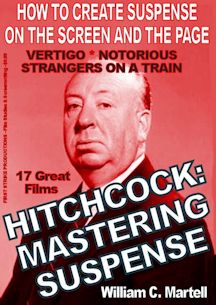
LEARN SUSPENSE FROM THE MASTER!
*** HITCHCOCK: MASTERING SUSPENSE *** - For Kindle!
Alfred Hitchcock, who directed 52 movies, was known as the *Master Of Suspense*; but what exactly is suspense and how can *we* master it? How does suspense work? How can *we* create “Hitchcockian” suspense scenes in our screenplays, novels, stories and films?
This book uses seventeen of Hitchcock’s films to show the difference between suspense and surprise, how to use “focus objects” to create suspense, the 20 iconic suspense scenes and situations, how plot twists work, using secrets for suspense, how to use Dread (the cousin of suspense) in horror stories, and dozens of other amazing storytelling lessons. From classics like “Strangers On A Train” and “The Birds” and “Vertigo” and “To Catch A Thief” to older films from the British period like “The 39 Steps” and “The Man Who Knew Too Much” to his hits from the silent era like “The Lodger” (about Jack The Ripper), we’ll look at all of the techniques to create suspense!
Only $5.99

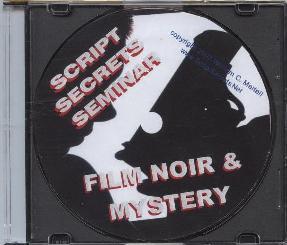
AUDIO CLASS!
NOIR & MYSTERY80 minute MP3 packed with information on writing Film Noir and Mystery scripts. Using examples from CHINATOWN to OUT OF THE PAST to DOUBLE INDEMNITY you'll learn how to create stories in this dark, twisted genre. How to plant clues, red herrings, suspects, victims, spider women, fallen heroes, the funhouse mirror world of noir supporting characters... and the origins of Film Noir in literature Noir dialogue and how noir endings are different than any other genre. All of the critical elements necessary to write in this critically popular genre.
The Noir & Mystery Class is only $15 (plus $5 S&H). First 20 on Limited Black Disk!
RECESSION SALE! $5 OFF!
IDEAS AND CREATIVITY - 80 minute MP3 packed with information. Tools to find ideas that are both personal *and* commercial. Hollywood wants scripts with High Concept stories... but not stupid scripts. Developing *intelligent* high concept ideas. How to turn your personal story into a blockbuster - or find your personal story in a high concept idea. Brainstorming and being creative. Ideas and Creativity is $10.00 (plus $5 S&H)
WRITING INDIES - Writing an Indie film? This class covers everything you need to know - from Central Locations to Confined Cameos. Using examples from SWINGERS, THE COOLER, STATION AGENT and others, this 80 minute MP3 is packed with information. How Indoe films challenge the audience (while mainstream films reassure the audience). Structures, using BOYS DON'T CRY, RUN LOLA RUN, HILARY & JACKIE, and others as example. Writing for a budget, writing for non-actors, getting the most production value out of your budget. Writing Indies is $10.00 (plus $5 S&H)
WRITING HORROR - The essentials of a horror screenplay - what do ROSEMARY'S BABY, NIGHT OF THE LIVING DEAD, THE EXORCIST, BRIDE OF FRANKENSTEIN, THE OTHERS and OPEN WATER have in common? This class will tell you! All of the critical elements necessary to write a script that scares the pants off the audience. Writing Horror is $10.00 (plus $5 S&H).
Click here for more information on CLASS MP3s!
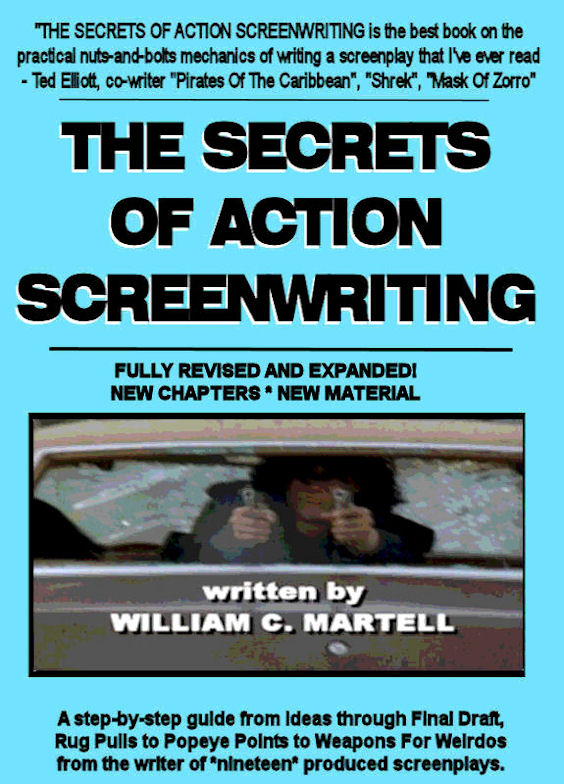
THE BOOK THAT STARTED IT ALL!
*** THE SECRETS OF ACTION SCREENWRITING *** - For Kindle!
*** THE SECRETS OF ACTION SCREENWRITING *** - For Nook!
Why pay $510 for a used version of the 240 page 2000 version that used to retail for $21.95? (check it out!) when
you can get the NEW EXPANDED VERSION - over 500 pages - for just $9.99? New chapters, New examples, New techniques!
"SECRETS OF ACTION SCREENWRITING is the
best book on the practical nuts-and-bolts mechanics of writing a screenplay I've ever read."
- Ted Elliott, co-writer of MASK OF ZORRO, SHREK, PIRATES OF THE CARIBBEAN and the sequels (with Terry Rossio). (ie; 4 of the top 20 Box Office Hits Of ALL TIME.)
Only $9.99 - and no postage!
READY TO BREAK IN?
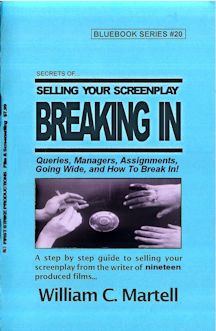
NEW!
*** BREAKING IN BLUE BOOK *** - For Kindle!
Should really be called the BUSINESS BLUE BOOK because it covers almost everything you will need to
know for your screenwriting career: from thinking like a producer and learning to speak their language,
to query letters and finding a manager or agent, to making connections (at home and in Hollywood) and
networking, to the different kinds of meetings you are will have at Studios, to the difference between
a producer and a studio, to landing an assignment at that meeting and what is required of you when you
are working under contract, to contracts and options and lawyers and... when to run from a deal!
Information you can use *now* to move your career forward! It's all here in the Biggest Blue Book yet!
Print version was 48 pages, Kindle version is over 400 pages!
$4.99 - and no postage!
NO KINDLE REQUIRED! Get the *free* app (any device, except your Mr. Coffee) on the order page on Amazon!
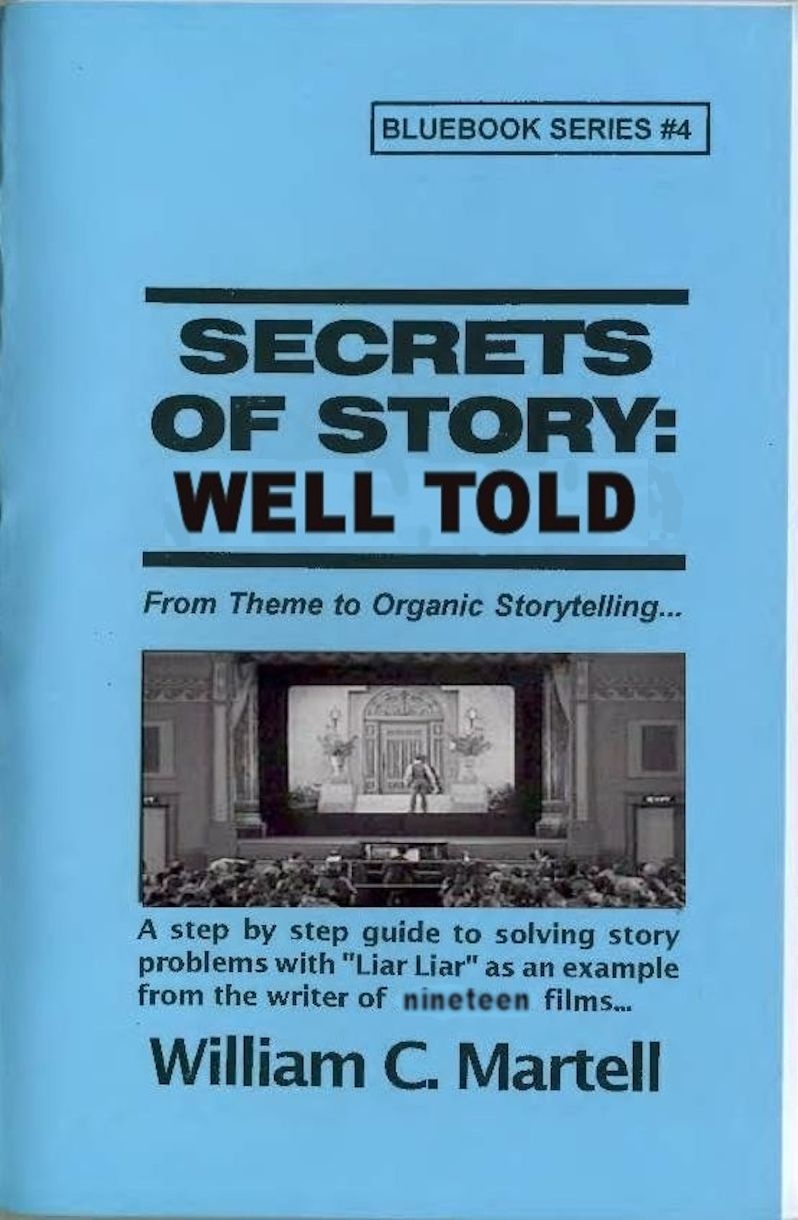
STORY: WELL TOLD!
*** STORY: WELL TOLD *** - For Kindle!
This book takes you step-by-step through the construction of a story... and how to tell a story well, why Story always starts with character... but ISN'T character, Breaking Your Story, Irony, Planting Information, Evolving Story, Leaving No Dramatic Stone Unturned, The Three Greek Unities, The Importance Of Stakes, The Thematic Method, and how to create personal stories with blockbuster potential. Ready to tell a story?
Print version was 48 pages, Kindle version is over 85,000 words - 251 pages!
Only $4.99 - and no postage!
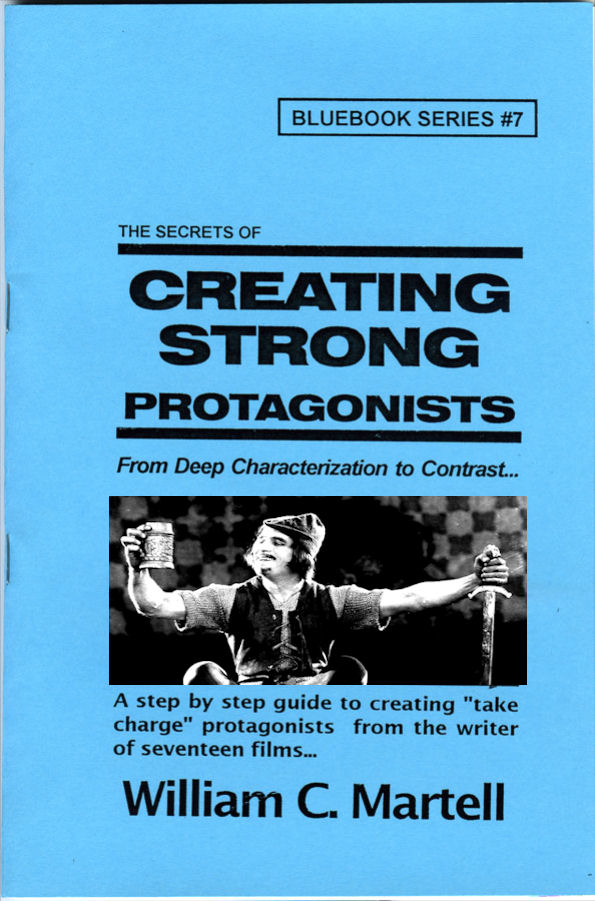
MOVIES ARE CHARACTERS!
*** CREATING STRONG PROTAGONISTS *** - For Kindle!
*** CREATING STRONG PROTAGONISTS *** - For Nook!
Expanded version with more ways to create interesting protagonists! A step-by-step guide to creating "take charge" protagonists. Screenplays are about characters in conflict... characters in emotional turmoil... Strong three dimensional protagonists who can find solutions to their problems in 110 pages. But how do you create characters like this? How do you turn words into flesh and blood? Character issues, Knowing Who Is The Boss, Tapping into YOUR fears, The Naked Character, Pulp Friction, Man With A Plan, Character Arcs, Avoiding Cliche People, Deep Characterization, Problem Protagonists, 12 Ways To Create Likable Protagonists (even if they are criminals), Active vs. Reactive, The Third Dimension In Character, Relationships, Ensemble Scripts, and much, much more. Print version is 48 pages, Kindle version is once again around 205 pages!
ONLY $4.99 - and no postage!
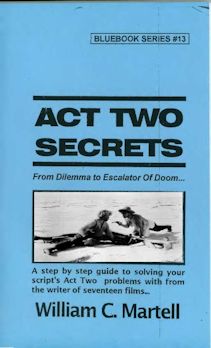
ACT TWO SOLUTIONS!
*** ACT TWO SECRETS *** - For Kindle!
Expanded version with more techniques to help you through the desert of Act Two! Subjects Include: What Is Act Two? Inside Moves, The 2 Ps: Purpose & Pacing, The 4Ds: Dilemma, Denial, Drama and Decision, Momentum, the Two Act Twos, Subplot Prisms, Deadlines, Drive, Levels Of Conflict, Escalation, When Act Two Begins and When Act Two Ends, Scene Order, Bite Sized Pieces, Common Act Two Issues, Plot Devices For Act Two, and dozens of others. Over 67,000 words (that’s well over 200 pages) of tools and techniques to get you through the desert of Act Two alive!
Print version was 48 pages, Kindle version is well over 200 pages!
ONLY $4.99 - and no postage!
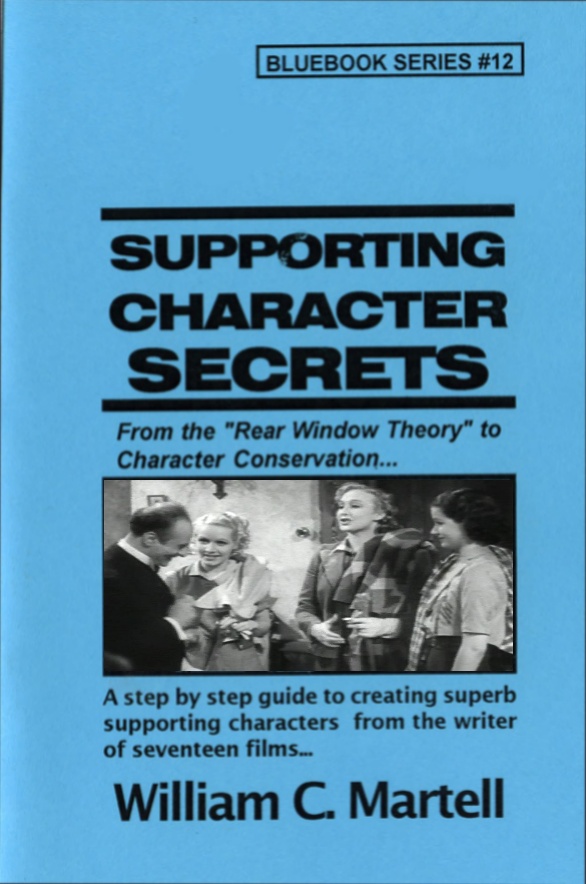
SUBPLOTS?
*** SUPPORTING CHARACTER SECRETS *** - For Kindle! (Exclusive)
Expanded version with more techniques to flesh out your Supporting Characters and make them individuals. Using the hit movie BRIDESMAIDS as well as other comedies like THE HANGOVER and TED and HIGH FIDELITY and
40 YEAR OLD VIRGIN and many other examples we look at ways to make your Supporting Characters come alive on the page.
Print version was 48 pages, Kindle version is around 170 pages!
ONLY $4.99 - and no postage!

ADVICE FROM 1920!
*** VINTAGE #1: HOW TO WRITE PHOTOPLAYS *** - For Kindle!
***
Screenwriting books have been around as long as films have. This series reprints vintage screenwriting books with a new introduction and history, plus new articles which look at how these lessons from almost 100 years ago apply to today’s screenplays. Anita Loos book is filled with information which still applies.
In addition to the full text of the original book, you get the full screenplay to Miss Loos' hit THE LOVE EXPERT, plus several new articles on the time period and women in Hollywood.
ONLY $2.99 - and no postage!
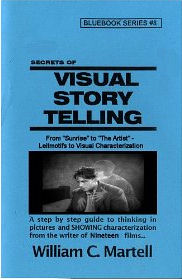
I WRITE PICTURES!
*** VISUAL STORYTELLING *** - For Kindle! (exclusive)
Show Don't Tell - but *how* do you do that? Here are techniques to tell stories visually! Using Oscar Winning Films and Oscar Nominated Films as our primary examples: from the first Best Picture Winner "Sunrise" (1927) to the Oscar Nominated "The Artist" (which takes place in 1927) with stops along the way Pixar's "Up" and Best Original Screenplay Winner "Breaking Away" (a small indie style drama - told visually) as well as "Witness" and other Oscar Winners as examples... plus RISE OF THE PLANET OF THE APES. Print version is 48 pages, Kindle version is over 200 pages!
ONLY $4.99 - and no postage!
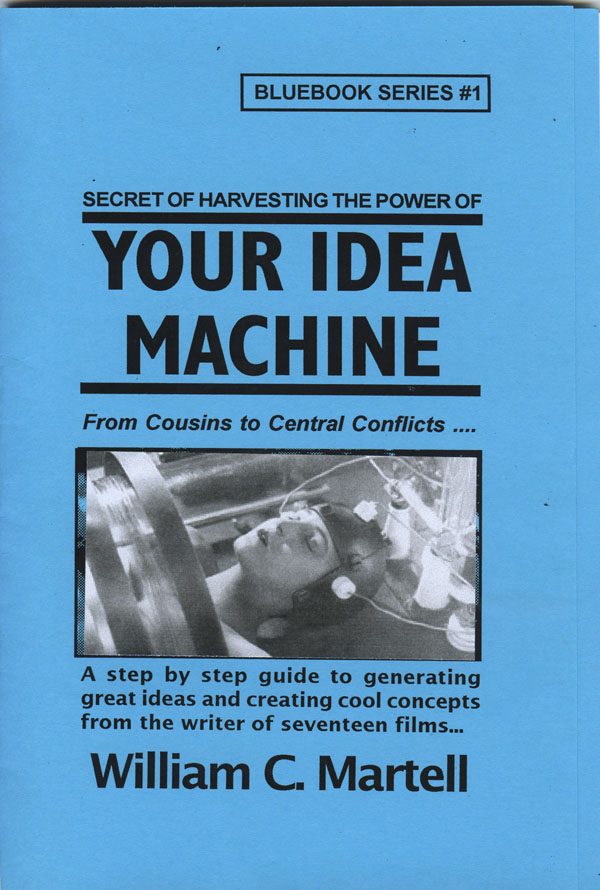
BEST SELLER!
*** YOUR IDEA MACHINE *** - For Kindle!
*** YOUR IDEA MACHINE *** - For Nook!
Expanded version with more ways to find great ideas! Your screenplay is going to begin with an idea. There are good ideas and bad ideas and commercial ideas and personal ideas. But where do you find ideas in the first place? This handbook explores different methods for finding or generating ideas, and combining those ideas into concepts that sell. The Idea Bank, Fifteen Places To Find Ideas, Good Ideas And Bad Ideas, Ideas From Locations And Elements, Keeping Track Of Your Ideas, Idea Theft - What Can You Do? Weird Ways To Connect Ideas, Combing Ideas To Create Concepts, High Concepts - What Are They? Creating The Killer Concept, Substitution - Lion Tamers & Hitmen, Creating Blockbuster Concepts, Magnification And The Matrix, Conflict Within Concept, Concepts With Visual Conflict, Avoiding Episodic Concepts, much more! Print version is 48 pages, Kindle version is over 175 pages!
Only $4.99 - and no postage!

PRO DIALOGUE TECHNIQUES!
*** DIALOGUE SECRETS *** - For Kindle!
*** DIALOGUE SECRETS *** - For Nook!
Expanded version with more ways to create interesting dialogue! How to remove bad dialogue (and what *is* bad dialogue), First Hand Dialogue, Awful Exposition, Realism, 50 Professional Dialogue Techniques you can use *today*, Subtext, Subtitles, Humor, Sizzling Banter, *Anti-Dialogue*, Speeches, and more. Tools you can use to make your dialogue sizzle! Special sections that use dialogue examples from movies as diverse as "Bringing Up Baby", "Psycho", "Double Indemnity", "Notorious", the Oscar nominated "You Can Count On Me", "His Girl Friday", and many more! Print version is 48 pages, Kindle version is over 175 pages!
Only $4.99 - and no postage!

Use your creative energy to focus on the content; let Final Draft take care of the style. Final Draft is the number-one selling application specifically designed for writing movie scripts, television episodics and stage plays. Its ease-of-use and time-saving features have attracted writers for almost two decades positioning Final Draft as the Professional Screenwriters Choice. Final Draft power users include Academy, Emmy and BAFTA award winning writers like Oliver Stone, Tom Hanks, Alan Ball, J.J. Abrams, James Cameron and more.
* * * Buy It!
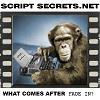
|

